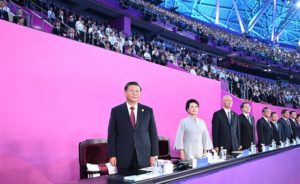Tihar: A festival of lights

By Bhesh Jung Badal
Tihar is one of the most popular five-day festival celebrated during the month of November in Nepal. These five days are also known as Yama Panchak – the five days of Yama. It is said that Yama, the god of death, goes to live at his sister Jamuna’s house on this occasion every year. Yama and his servants as well are expected to be more accountable to propitiations on these occasions than at any other time of the year.
Crow’s Day: Crows are worshipped during the Tihar festival. The more devout people go to river banks for their ritual bath early in the morning. After the bath, burning wicks soaked in mustard oil are put on small leaf plates and floated on the waters, a gesture showing devotion to Lord Yama. On this day the first portion of the family meal is offered to the crow, the loyal messenger of the god of death. It is believed that much sin would accrue if the crow is not fed before family members.
For traditional physicians, the day is still more significant. It is believed that Dhanwantari – the physician of the gods, was born on this day. So, the practitioners of the healing arts worship Dhanwantari, asking for his blessings.
Dog’s Day: Yama’s worship is conducted in the morning. After this, comes the turn of Yama’s gatekeeper – the dog. The dog’s association with Yama and its power as the stead of Bhairba – the god of anger, is remembered in its worship. Mustard oil is applied to the dog’s forehead before giving the red Tika mark. Garland of flowers is put around its neck, and it is worshipped with flowers and incense. Food with all kind of delicacies are fed to them, and only after this can the family members eat their morning meal.
Cow’s Day or Laxmi Puja: Attention is given during Tihar to clean and to paint and decorate the houses, the shops in the market and even government offices. Laxmi– the goddess of wealth and prosperity is considered to be partial to lights and cleanliness. The occasion is celebrated in two stages. In the morning, cows are worshipped as the live embodiment of the goddess of prosperity. As the descendant of the mythical wish– granting cow– Kamadhenu, and as the live symbol of the spirit of the earth – the great nourisher of life. The cow is especially sacred to the Hindus.
The evening is noted for the famous festival ‘festival of light’. Rows of lamps, either the traditional lamps or small clay plates or all kinds of wax candles and electric bulbs are lit on all windows, doors, terraces and path ways. The main market areas are virtually ablaze with lights and fire – crackers. In this setting, preparation is started for worshipping the goddess of wealth and prosperity.
In front of the main gate of every house starting from the circle is traced a small trail either with cow dung plaster or with rice paste which, goes into the house to end in the room where Laxmi is worshipped. People also print a trail of small foot – print likes marks using the heels of their hand to show Laxmi the place where her devotees await her in the house. On a plate, placed above a small mound of newly harvested unhusked rice, is put an image of Laxmi for the worship. The worship can be a prolonged affair, taking hours, if all the prescribed rituals are fully observed. At the end, every article of domestic or craft use – pots and pans, gardening or farming implements are worshipped. On this day when all monetary transactions are taboo. Perhaps the only acceptable exception is the giving away of monetary gifts and edibles to groups of Bhailo singers, who visit the houses in their loyalty is a time– honored practice whose beginning is lost somewhere in the past.
The fourth day of the Tihar festival is celebrated with the worship of Gobardhan– The mythical mountain which is said have been raised by Lord Krishna with the little finger of his hand. This show of miraculous power was performed to protect Lord Krishna’s clansmen from the anger of Indra, the heaven’s king, which poured down from the heavens in the from of torrential rains. A small round of cow–dung is made to represent the Govardhan mountain, and devotees of Lord Krishna worship is in the morning.
However, the day’s significance is underlined more definitely because it is the first day of the Nepal Samvat – the Nepalese era. Despite the official adoption of the Vikram era, the importance of the Nepal Samvat has not dimmed, especially because of the Newar practice of self worship’ – Maha Puja – on this day. The worship of ‘self’ is aimed at propitiating the spirit dwelling in one’s body. Placating of the unknown dark forces within one’s self and continuing resurgence of positive forces is assured by this worship whose prescribed rituals are Tantrist in nature.
As a mark of celebrating the new year colourful arches with banners carrying the “Happy New Year” messages are raised at almost every city block in Kathmandu. A recent addition to the usual celebration is a large procession of celebrants carrying placards with new year messages in old Newari script and in Nepali and English driving on all kinds of motorbikes, bicycles and sometimes, even on rickshaws on the roads of Kathmandu, Patan and Bhaktapur.
An interesting story is told about the beginning of the Nepalese era. In the last quarter of the ninth century, Anand Malla, the King of Bhaktapur was told by his astrologer that on a particular day and at particular time if the sand from a certain confluence of the Vishnumati River would be taken that would turn into gold. The king sent some men to Kathmandu to bring the sand from the place ascertained. When the men were returning from the river with their sand loads, a small trader of Kathmandu, Shakha Dhar, was surprised to know that these men a particular place. The inducement of a small monetary gift was enough to convince the men had come from Bhaktapur to get sand form a particular place. The inducement of a small monetary gift was enough to convince the men that they could dump their loads at Shakha Dhar’s place and easily get refills. The sand dumped at Shakha Dhar’s place turned into gold whereas the sand finally taken to Bhaktapur did not change at all. Shakha Dhar, decided to use this undreamt-of fortune in a special way. He approached King Jayadev of Kathmandu Valley.
Brother’s Day: The last day of Tihar festival, is the day of Bhai Tika or the Brother’s day. The five-day sojourn of Lord Yama at his sister’s place is especially meant to celebrate this day when every sister in Nepal worships her brother, putting the prescribed Tika marks, and gives her blessings. At every household the rituals are more or less the same. The brothers sit-down on a seat for the Tika; Lord Yama is involved by the sister and worshipped.
After this, a circle is drawn around the sitting brother with mustard oil and water by the sister. This ensures that no evil spirit would harm the brother at the time of Tika. The brother is then given a multicolored vertical Tika Mark on his forehead and worshipped with flowers and red powder. The brother too gives Tika to his sister. All kinds of sweets and fruits are presented to the brother and the brother, in turn, gives a present of money or clothes. All the family members celebrate the occasion over a feast.
Newari New Year and Mha Puja
The Newar community of Kathmandu valley celebrate Mha Puja, worshipping of one’s body or self. It is believed that the body is divine, that the holy spirit dwells within, not only within each individual, but in every object, inanimate as well as living. On this day, tools of every trade are cleaned and worshipped, incensed, garlanded and adorned with a Tika. People of all occupations are seen repairing, adorning and reciting sacred mantras so that the tools will be faithful servants in the coming year. Mha Puja day is also the new year day of Newar people, according to Nepal Samvat, begun in A.D. 880.
Nov. 13 , 2020










